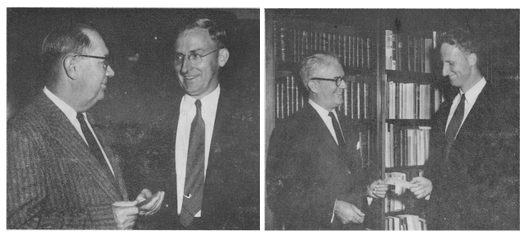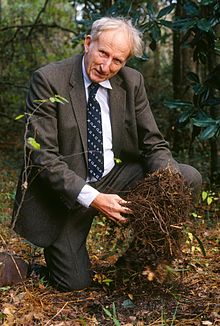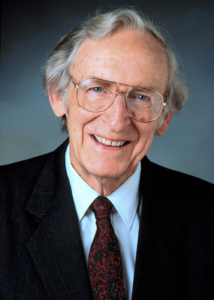How One Family Shaped Bay Research: Tracking the Odum Lineage
The Odum name has been largely synonymous with ecology for decades. Despite that, many younger scientists may not be fully aware of the Odum family’s tremendous contributions to the field of ecology and specifically, the implications of their research on how the Chesapeake Bay is managed.
Brothers, Howard “H.T.” and Eugene Odum, along with Eugene’s son, Bill, left a legacy that influences ecosystem management around the world. Lucky for us, many of the Chesapeake’s leading scientists trained directly with an Odum, and we were fortunate enough to speak with some of them.
Eugene and his younger brother, H.T., challenged traditional notions of how natural systems functioned, in relation to each other and human communities. While the concept of energy flow and interactions and energy exchanges across different ecosystems seem completely obvious now, those ideas were seen as controversial in academic settings in the 1950’s.
The Odums thought about feedbacks – where products of a given reaction could cycle back to either amplify or mute additional reactions – and how these feedbacks within an ecosystem would affect its response to inputs and outputs from other systems (such as adjacent watersheds). They were not limited by one discipline; instead, they combined principles of biology, chemistry, physics, and engineering to understand large systems. This way of thinking revolutionized the field and substantially changed the way scientists model and observe ecosystems.
“This whole notion of feedbacks is really important,” explained Walter Boynton, Professor Emeritus at the University of Maryland Center for Environmental Science Chesapeake Biological Laboratory, and former student of H.T. Odum. “H.T. was a leading voice in not just talking about feedbacks, but incorporating them into early simulation models. Now, when we look at the Chesapeake Bay model, it’s loaded with feedbacks.”

In one of their earlier collaborations, the brothers worked on a project funded by the US Atomic Energy Commission on the ecosystem function at Eniwetok Atoll, where the US tested nuclear weapons. Their work focused on the importance of coral reef ecosystems and was awarded the Mercer Prize from the Ecological Society of America in 1956. Left: President O.C. Aderhold (left), University of Georgia, presents Dr. Eugene P. Odum the George Mercer Award. Right: Dr. Howard T. Odum (right) receives the award from Dr. Logan Wilson (left). Source
Academic Legacy of the Odum Brothers
Eugene is one of the first scientists credited with bringing forward the importance of “ecology” and “ecosystems,” and understanding how ecological systems interact with one another.

Howard Thomas Odum. Photo by Mark T. Brown. Source
H.T. added to this work, defining “ecology” as the study of large entities (ecosystems) at the “natural level of integration” in his dissertation. H.T. served in the Air Force during WWII as a meteorologist, which pushed his early thinking about systems and interactions. As he expanded on those ideas, H.T. started to think about how ecosystems could be modeled with electrical energy networks to understand the energy flow pathways in ecosystems.
H.T. often used electrical circuits and the movement of electrons to demonstrate how materials like carbon flow in an ecosystem. He was later known for adapting the Laws of Thermodynamics into his work. For example, in the second law of thermodynamics, matter cannot be created or destroyed. H.T. thought this way about ecosystems; he measured inputs and outputs into a system, accounting for as many variables as possible.
Lora Harris, Associate Professor at the University of Maryland Center for Environmental Science Chesapeake Biological Laboratory, is one of the many “Odumites” working in the Bay. She worked and studied closely with Scott Nixon, who was one of H.T.’s students, and noted that this way of thinking was a demonstration of early mass balance exercises.
“Doing a mass balance is like balancing your checking account, but using the currency of nutrients,” she explained. “Doing this accounting of what’s coming in and out is a trademark of Odum students…It’s basically how calculating the TMDLs [total maximum daily loads of nutrients] works today.”
“The idea of impacts and feedbacks is a very H.T. Odum way of thinking,” said Jeremy Testa, Associate Professor at the University of Maryland Center for Environmental Science Chesapeake Biological Laboratory. Testa studied under Charles Hall at the State University of New York, and then under Michael Kemp at the University of Maryland, both of whom were students of H.T. Odum. “He applied the notion of feedbacks from his background in electrical engineering. He’d draw circuits with resistors and conductors to understand interactions within ecosystems, such as nutrient cycles.”
“Whether you were doing a mass balance or modeling, you had to develop a currency that was connected to the energetics of the system,” added Harris. “This approach has certainly influenced me personally and Scott Nixon.” Nixon would later help develop the first numerical simulation model and contributed to the numerical model of the Chesapeake Bay. “Scott was always extremely proud of his academic heritage, stretching back to H.T. and [H.T.’s advisor] Evelyn Hutchison.”
Building on thermodynamics and evolution, Odum and physicist Richard Pinkerton put forward the controversial idea that ecosystems maximize power. At the time, the leading theory was that ecosystems maximized efficiency, but H.T. disagreed and proposed that maximizing power was a fundamental law of thermodynamics.
“The way I explain it to my students is, an ecosystem operates more like a Mustang than a Prius,” explained Harris. “Odum proposed that ecosystems are organized to maximize power over efficiency. The Mustang wants to go fast, whereas the Pruis is trying to be efficient.”
In the latter part of his career, H.T. and David Scienceman developed the ideas of “emergy,” or “embodied energy” or “energy memory.” Odum was interested in how ecosystems are formed by the use of energy from the past. He stated, “emergy is a measure of energy used in the past and thus is different from a measure of energy now. The unit of emergy (past available energy use) is the emjoule, as distinguished from joules used for available energy remaining now.” While this idea is still controversial and not widely tested, it remains one of his most significant scientific contributions.
Boynton recalled that H.T. was an eccentric advisor who pushed his students to think broadly. “All five of us graduate students would be sitting in a large room at the University of Florida’s Department of Environmental Engineering, and he would come zooming in there at any point of the day or night and he would be thinking about something that he wanted to share with us…It was pretty creative and intense. We’d even find him asleep in there some mornings having worked through the night trying to understand some issue… I’ve never met anyone quite like him.”
Science communication: the Odum way
“Odum publications were what everyone was reading,” said Carl Hershner, former student of Bill Odum and now Professor and Director, Center for Coastal Resources, at the Virginia Institute of Marine Science (VIMS). “Their ideas spread like wildfire through scientific publications and presentations. Their students proliferated and helped spread their ideas further.”

Dr. Eugene Odum director emeritus of ecology at the University of Georgia. Photo taken 08/23/93. (University Communications / University of Georgia, Rick O’Quinn).
H.T. and Eugene co-wrote the first ecology textbook, Fundamentals of Ecology, in 1953. That book has been translated into 12 languages and adapted in 5 subsequent editions. The main message of the book, and the heart of their legacy, can be summarized by “the whole is greater than the sum of its parts.”
Not just groundbreakers in academic research, the Odums were also among the earliest to understand the importance of science communication. In addition to their books, they often gave talks aimed at non-scientific audiences. Eugene often advocated for environmental regulations at the national level and donated most of his wealth from his textbooks to causes he supported.
“H.T. was a brilliant communicator,” said Boynton. He added that one time at an event at the Sweden Royal Academy, H.T. famously dropped his slides right before he was about to begin. He told the audience the order didn’t matter too much – and he simply kept talking.
“Odum students are phenomenal communicators to managers and non-scientists,” Harris added, noting that their ability to explain their ideas helped make their theories more understood and accepted.
Influence on modern Chesapeake Bay management
When it comes to Bay management, it’s hard to picture a model of the Chesapeake Bay without Odum principles, like including humans or understanding feedbacks. “It’s hard to even imagine having the same impact [as the Odums] today,” said Harris.
Bill Odum was greatly influenced by his father’s and his uncle’s systems approach and applied them to his work on the Chesapeake Bay wetlands during his time as a researcher at the University of Virginia. Hershner stated, “they [the Odums] were the first to suggest that all the things we observe are linked together. What happens to one thing affects another.”
The idea of setting restoration and protection goals for wetlands was unheard of before their research. H.T. made great strides in the field of wetlands ecology, and his work helped pave the way for the “no net loss” wetlands policy. His studies on coastal wetlands sought to understand how wetlands could be used to filter human waste and improve water quality. At the time, dredging and filling wetlands was common.
They even get some credit for the Chesapeake Bay Watershed Model. The Odums, particularly H.T., developed some of the first ecosystem models that included people, feedbacks, and large interconnecting systems. “I’d put H.T. up there as the father of ecological modeling,” said Boynton.
Hershner noted that adding humans to models was pushing the boundaries of modeling at the time: “Now, we’re more focused on people and how they influence the flow of materials and energy through the system.”
But their ideas were not without pushback – many scientists at the time scoffed at the idea of using humans in an ecological model. “We were considered by many as half crazy renegades,” explained Boynton.
They also faced doubt on the size of the models themselves. “H.T. knew that in order to model a system, you had to scale the model bigger than the problem,” said Boynton. “For example, if you wanted to model rockfish, you needed to model at a scale that includes part of the food web that supports the baby rockfish. Then we can get insights into making predictions that are realistic.”
Testa added, “H.T. brought this formal, quantitative framework for analyzing ecosystems. That’s crucial to how we study ecosystems today and which tools we use to guide the management.”
Many thought that creating a model that complex would “blow up” or be inherently unstable. While their models seemed large at the time, their early models only included 2 or 3 boxes due to limitations in computational capabilities and understanding. Boyton exclaimed, “H.T. would probably roll over in his grave if he saw the water quality model of the Bay right now with 55,000 cells!”
It’s hard to imagine leaps in ecology as big as the Odums took, but Bay scientists and managers are carrying on the torch. For one, ecologists are thinking like sociologists and economists now more than ever. “People are bringing socioeconomic interactions and engineering interventions into the story,” explained Testa. “A lot of work is being done on the outcomes of restoration and how much different solutions cost. We’re bringing society more fully into the restoration plan.”
“H.T. would love the [Chesapeake Bay] model, with all the things interacting with each other,” said Boynton. “Many of the people working on the models have never heard of Odum, but they are standing on his shoulders, as I am.”
